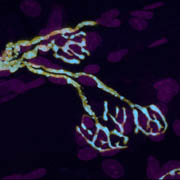June 4, 2007
Mice Show How Mitochondria Flow in Nerve Cells
[Quick Summary: An engineered mouse can allow scientists to watch the flow of energy supplies within nerve cells suspected to be impaired in ALS. These “MitoMice” should provide an easier way to study the cellular traffic in the disease.]
By improving the techniques available to study the role of mitochondria in the nervous system in amyotrophic lateral sclerosis (ALS, also known as Lou Gehrig's disease), a team of researchers, including ALS Association-funded investigator Robert Burgess, Ph.D., at The Jackson Laboratory, Bar Harbor, Maine, are paving the way to target therapies to specific cells affected and the processes that could be repaired to change the disorder’s course.
 |
| Mitochondria in nerve endings on muscle glow blue in transgenic mice. Cell nuclei are purple. Image courtesy Dr. Thomas Misgeld. |
“I hope this progress will prompt others in the ALS field to take advantage of the mice,” Burgess said. “Experiments in SOD1 mice will be the next step in this project.”
Funded in part by a grant from The ALS Association to Burgess, the team has engineered the animals they have named MitoMice in which the cellular power plants called mitochondria are selectively labeled by gene manipulation to glow under the microscope. The mice are normal but reveal the flow of these key organelles within their cells.
The motor neurons, exceptionally long nerve cells, die selectively in ALS. Their mitochondria must reach to nerve endings that connect to and contract muscle, in some instances up to a meter away from their cell bodies in the spinal cord. Scientists suspect that the flow of mitochondria is impaired in the motor neurons affected by ALS. The MitoMice should provide an easier way to study the role of mitochondrial traffic in the disease.
Future plans for the researchers include studying the mitochondrial flow in MitoMice bred with mice that have another mutated protein linked to some inherited forms of ALS. By crossing MitoMice with the SOD1 mutated mice (that is, with a gene change that produces a toxic version of the protein, copper zinc superoxide dismutase), the resulting changes in mitochondria transport might lead to important advances in understanding the disease process and how to alter it.
Other researchers involved in this project are Thomas Misgeld, M.D., Martin Kerschensteiner, M.D., and Florence Bareyre, Ph.D., in Munich, working with Jeff Lichtman, M.D., Ph.D., at Harvard.
The Jackson Laboratory in Bar Harbor, Maine, will be able to provide these mice to researchers. Refer to the “Strains Under Development” page of The Jackson Laboratory website to specify interest in these mice or search for stock number 6614 (MitoC) or 6617 (MitoS) for more information.
Burgess is funded by The Alan L. Phillips Discovery Grant Award, which is made possible through support from Morton and Malvina Charlestein.
Read about mitochondria in ALS for more information.
View the PubMed article here.